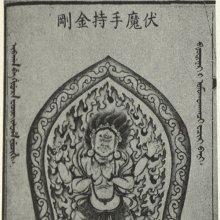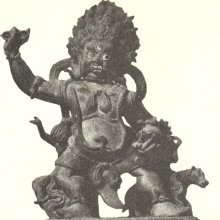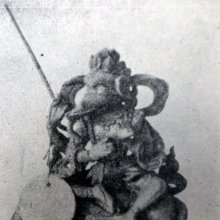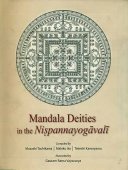Bhutadamara, Bhūtaḍāmara: 6 definitions
Introduction:
Bhutadamara means something in Buddhism, Pali, Hinduism, Sanskrit. If you want to know the exact meaning, history, etymology or English translation of this term then check out the descriptions on this page. Add your comment or reference to a book if you want to contribute to this summary article.
Images (photo gallery)
In Buddhism
Tibetan Buddhism (Vajrayana or tantric Buddhism)
Source: archive.org: The Indian Buddhist IconographyBhūtaḍāmara (भूतडामर) refers to one of the various emanations of Akṣobhya having their Sādhana described in the 5th-century Sādhanamālā (a collection of sādhana texts that contain detailed instructions for rituals).—His Colour is black as collyrium; his Appearance is terrible; his Mudrā is the bhūtaḍāmara; he has four arms.—Three sādhanas in the Sādhanamālā describe the form of Bhūtaḍāmara, who is terrible and awe-inspiring, with ornaments of snakes, canine teeth, and garlands of skulls.
The Dhyāna (meditation instructions) of Bhūtaḍāmara described in the Sādhanamālā as follows:—
“The worshipper should conceive himself as (Bhūtaḍāmara) who is wrathful in appearance and whose person radiates fiery flames. He is four-armed, terribly angry, and is bright like a broken lump of collyrium. He weilds the vajra in the right hand and shows the tarjanī in a threatening attitude in the left. His face appears terrible with bare fangs and he is decked in ornaments of eight serpents. He has the garland of skulls on the crown and is capable of destroying the three worlds. He stands firmly in the pratyālīḍha attitude and is resplendent like myriads of suns. He tramples under his feet, the god Aparājita, and exhibits his special mudrā”.
Bhūtaḍāmara is the principal deity in the bhūtaḍāmara-maṇḍala of the Niṣpannayogāvalī. Here he tramples upon the prostrate form of Aparājita, and is violent in appearance. He is four-armed. He wields the vajra in the right hand raised m a menacing attitude. In the left he shows the tarjanī and the noose. With the two principal hands, he shows the ḍāmara-mudrā.

Tibetan Buddhism includes schools such as Nyingma, Kadampa, Kagyu and Gelug. Their primary canon of literature is divided in two broad categories: The Kangyur, which consists of Buddha’s words, and the Tengyur, which includes commentaries from various sources. Esotericism and tantra techniques (vajrayāna) are collected indepently.
Languages of India and abroad
Sanskrit dictionary
Source: Cologne Digital Sanskrit Dictionaries: Edgerton Buddhist Hybrid Sanskrit DictionaryBhūtaḍāmara (भूतडामर).—(see Ḍāmara), name of a deity: śrī-Bh° Sādhanamālā 512.15, etc.
Source: Cologne Digital Sanskrit Dictionaries: Aufrecht Catalogus CatalogorumBhūtaḍāmara (भूतडामर) as mentioned in Aufrecht’s Catalogus Catalogorum:—
—[commentary] read by Sadāśiva.
Bhūtaḍāmara (भूतडामर):—[=bhūta-ḍāmara] [from bhūta > bhū] m. or n. Name of 2 Tantras
[Sanskrit to German]
Sanskrit, also spelled संस्कृतम् (saṃskṛtam), is an ancient language of India commonly seen as the grandmother of the Indo-European language family (even English!). Closely allied with Prakrit and Pali, Sanskrit is more exhaustive in both grammar and terms and has the most extensive collection of literature in the world, greatly surpassing its sister-languages Greek and Latin.
See also (Relevant definitions)
Partial matches: Damara, Bhuta, Tamara.
Starts with: Bhutadamaratantra.
Full-text: Bhutoddamara, Bhutadamari, Nilaganesha, Bhutoddamaratantra, Damara, Ganapati, Somasiddhanta.
Relevant text
Search found 1 books and stories containing Bhutadamara, Bhūtaḍāmara, Bhuta-damara, Bhūta-ḍāmara; (plurals include: Bhutadamaras, Bhūtaḍāmaras, damaras, ḍāmaras). You can also click to the full overview containing English textual excerpts. Below are direct links for the most relevant articles:
The Indian Buddhist Iconography (by Benoytosh Bhattachacharyya)
Related products



